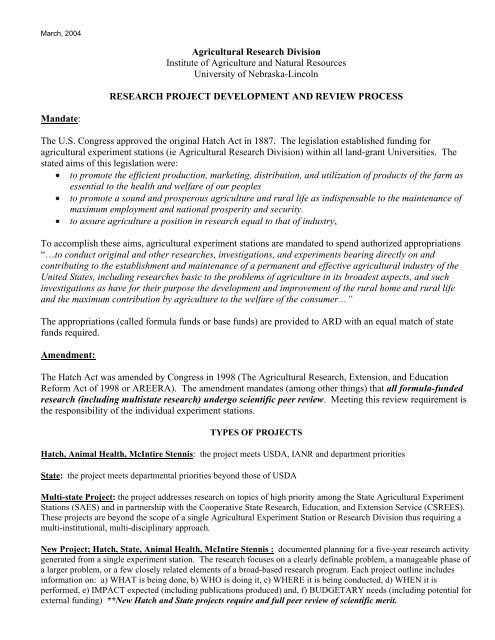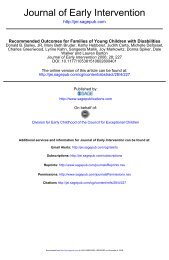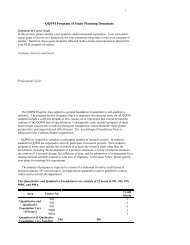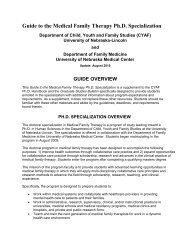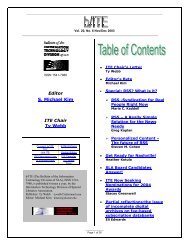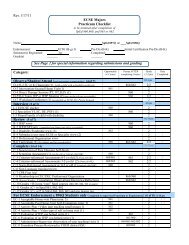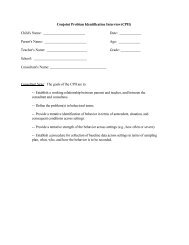Research Project Development and Review Process
Research Project Development and Review Process
Research Project Development and Review Process
You also want an ePaper? Increase the reach of your titles
YUMPU automatically turns print PDFs into web optimized ePapers that Google loves.
March, 2004Agricultural <strong>Research</strong> DivisionInstitute of Agriculture <strong>and</strong> Natural ResourcesUniversity of Nebraska-LincolnRESEARCH PROJECT DEVELOPMENT AND REVIEW PROCESSM<strong>and</strong>ate:The U.S. Congress approved the original Hatch Act in 1887. The legislation established funding foragricultural experiment stations (ie Agricultural <strong>Research</strong> Division) within all l<strong>and</strong>-grant Universities. Thestated aims of this legislation were:• to promote the efficient production, marketing, distribution, <strong>and</strong> utilization of products of the farm asessential to the health <strong>and</strong> welfare of our peoples• to promote a sound <strong>and</strong> prosperous agriculture <strong>and</strong> rural life as indispensable to the maintenance ofmaximum employment <strong>and</strong> national prosperity <strong>and</strong> security.• to assure agriculture a position in research equal to that of industry,To accomplish these aims, agricultural experiment stations are m<strong>and</strong>ated to spend authorized appropriations“…to conduct original <strong>and</strong> other researches, investigations, <strong>and</strong> experiments bearing directly on <strong>and</strong>contributing to the establishment <strong>and</strong> maintenance of a permanent <strong>and</strong> effective agricultural industry of theUnited States, including researches basic to the problems of agriculture in its broadest aspects, <strong>and</strong> suchinvestigations as have for their purpose the development <strong>and</strong> improvement of the rural home <strong>and</strong> rural life<strong>and</strong> the maximum contribution by agriculture to the welfare of the consumer…”The appropriations (called formula funds or base funds) are provided to ARD with an equal match of statefunds required.Amendment:The Hatch Act was amended by Congress in 1998 (The Agricultural <strong>Research</strong>, Extension, <strong>and</strong> EducationReform Act of 1998 or AREERA). The amendment m<strong>and</strong>ates (among other things) that all formula-fundedresearch (including multistate research) undergo scientific peer review. Meeting this review requirement isthe responsibility of the individual experiment stations.TYPES OF PROJECTSHatch, Animal Health, McIntire Stennis: the project meets USDA, IANR <strong>and</strong> department prioritiesState: the project meets departmental priorities beyond those of USDAMulti-state <strong>Project</strong>: the project addresses research on topics of high priority among the State Agricultural ExperimentStations (SAES) <strong>and</strong> in partnership with the Cooperative State <strong>Research</strong>, Education, <strong>and</strong> Extension Service (CSREES).These projects are beyond the scope of a single Agricultural Experiment Station or <strong>Research</strong> Division thus requiring amulti-institutional, multi-disciplinary approach.New <strong>Project</strong>; Hatch, State, Animal Health, McIntire Stennis : documented planning for a five-year research activitygenerated from a single experiment station. The research focuses on a clearly definable problem, a manageable phase ofa larger problem, or a few closely related elements of a broad-based research program. Each project outline includesinformation on: a) WHAT is being done, b) WHO is doing it, c) WHERE it is being conducted, d) WHEN it isperformed, e) IMPACT expected (including publications produced) <strong>and</strong>, f) BUDGETARY needs (including potential forexternal funding) **New Hatch <strong>and</strong> State projects require <strong>and</strong> full peer review of scientific merit.
March, 2004Revised <strong>Project</strong>; Hatch, State, Animal Health, McIntire Stennis : documented planning for a five-year researchactivity that is a continuation of a previously approved project. Revised projects must have the same or very similartitle, updated objectives that demonstrate continuation from or expansion of objectives from the previous project, aprogress report <strong>and</strong> publication record, <strong>and</strong> predicted 5-year budgetary needs. **Revised Hatch <strong>and</strong> State projectsrequire a modified review with the Department Head <strong>and</strong> ARD Dean or Dean’s representative.Extended <strong>Project</strong>; Hatch, State, Animal Health, McIntire Stennis: at the end of the 5 years, a one-year extensioncan be requested by the Department Head to complete the objectives of the project. **A new project is required by theend of the one year periodMultistate projects: Please see the comprehensive guide to multi-state projects at http://www.wisc.edu/ncra/**Reporting outlines for Nebraska contributions to approved multistate research activities must follow a specificformat <strong>and</strong> must be reviewed by a modified process with Department Head <strong>and</strong> ARD Dean/Dean’s representative.BRIEF GLOSSARYImpact The economic, social, health or environmental consequences derived as benefits for the intended users. Theseare usually quantitatively measured either directly or indirectly as indicators of benefits. (An example is improvedhuman nutrition through genetically engineering rice to contain the precursors to vitamin A.)Indicators Surrogate measures of research outcomes or benefits, often used when directly measuring researchoutcomes or benefits would not be feasible. (For example, an indicator of improved water quality might be the increaseduse of biological control technologies in crop agriculture.)Milestone: A time line-linked accomplishment that needs to be completed before subsequent activities can begin, orcan be completed. As an example, to genetically engineer a crop by 2005 a transformation method needs to be reducedto practice by 2002 (a milestone).Outcome: Outcomes describe the significance of the results, showing in what ways the end user will benefit. (Forexample, the outcome from the adoption of a new cultivar might be increased production, or greater profitability.)Output: Outputs are the results of research activities, such as data, information, biological or physical materials <strong>and</strong>observations. (For example, the output from a plant-breeding program might be a named variety. The output from asurvey might be the analyzed survey results.)Professional Year: This is the portion of time for persons who hold positions in professional categories <strong>and</strong> who areassigned to research activities of the project. Such professionals usually hold a bachelors <strong>and</strong>/or masters degree(s).Graduate students, by virtue of their degree <strong>and</strong> acceptance in graduate school, may be categorized as "professionals."Scientist Year: This is the portion of time for scientists (Assistant Professor, <strong>Research</strong> Assistant Professor <strong>and</strong> above)who are responsible for creative scientific study, thought, originality, judgments, <strong>and</strong> accomplishments directlyassignable to the activity reported.Stakeholder or end-user: Individuals, or groups of individuals, or organizations/institutions with a direct interest in theoutcome of public investments in agricultural research <strong>and</strong> education. This could be producers of agricultural products,consumers of agricultural products, or sponsors of research activities from federal <strong>and</strong> state governments.Technical Year: This is the portion of time for technicians, aides, <strong>and</strong> laboratory assistants assigned in support of aproject or an activity.
March, 2004<strong>Process</strong> for Revised <strong>Project</strong>sA project leader may elect to revise an on-going research project outline instead of developing a new projectoutline if:! the project outline is reviewed <strong>and</strong> approved before the termination date of the previous project;! the research area remains a high priority for the investigator, department <strong>and</strong> ARD, <strong>and</strong>;! the project title remains the same <strong>and</strong> project objectives are similar to the previous project.Because revised projects were originally reviewed when the project was first initiated, a Modified <strong>Review</strong> willbe used. <strong>Review</strong> must be completed before the project termination date or it will be h<strong>and</strong>led as a new project.1. Informal <strong>Review</strong>: Same as for a new project.2. Departmental <strong>Review</strong>: Same as for a new project.3. Submission to Dean’s Office: The Department Head/Chair submits the outline to the Dean of the ARDidentifying any ad hoc reviewers <strong>and</strong> people who have previously reviewed the project. A nontechnical“Statement of Accomplishments” should accompany the proposal when submitted to the ARD Dean’sOffice. The statement should highlight the most significant results <strong>and</strong> should not exceed 250 words inlength.4. Divisional <strong>Review</strong>: The Division <strong>Review</strong> Panel will be chaired by the ARD Dean’s Office representative<strong>and</strong> will include the Department Head, the District Center Director (if applicable) <strong>and</strong> the project leader(s).The same questions listed in the Peer <strong>Review</strong> section for a new project will be considered in evaluatingrevised projects including use of the “<strong>Research</strong> Proposal Peer <strong>Review</strong> Form.”5. Preparation of Final Outline <strong>and</strong> CRIS Forms: Same as for a new project.6. <strong>Project</strong> Approval: Same as for a new project.Nebraska Contribution to a Multi-state <strong>Project</strong>Multi-state <strong>Research</strong> <strong>Project</strong>s are subjected to intensive review prior to their approval at the federal leveltherefore; a modified review is used to evaluate the Nebraska contribution to the regional project. The specificobjectives <strong>and</strong> research protocol of the regional project that Nebraska researchers will address are reviewed.The entire regional research proposal should be submitted as an appendix to the work proposed for Nebraska.<strong>Review</strong> <strong>Process</strong> Nebraska Contribution to a Multi-state <strong>Project</strong>1. Informal <strong>Review</strong>: Same as for new project.2. Departmental <strong>Review</strong>: Same as for new project.3. Submission to the Dean of ARD: Same as for a revised project excluding “Statement ofAccomplishments”4. Divisional <strong>Review</strong>: Same as for a revised project.5. Preparation of Final Outline <strong>and</strong> CRIS Forms: Same as for a new project.6. <strong>Project</strong> Approval: Same as for a new project.Extension of a <strong>Research</strong> <strong>Project</strong>A research project may be extended for up to one year past the termination date if additional time is needed tocomplete project objectives. A formal request must be initiated <strong>and</strong> justified by the project leader <strong>and</strong>approved <strong>and</strong> forwarded to ARD by the department head 30 days prior to the termination date. Faculty at
March, 2004the <strong>Research</strong> <strong>and</strong> Extension Centers (REC) must transmit all correspondence through the REC Director. TheDean of the ARD will make the final decision on extending a project. If an extension is granted, a revision ofthe project is no longer an option. At the end of the extension, the project must be terminated <strong>and</strong> new projectproposal submitted.Preparation of Final Outline <strong>and</strong> CRIS Forms:***REQUIRED FOR ALL PROJECTS***The final project outline, after completing any necessary revisions, must be submitted electronically to theARD office. The project leader must also submit online information to the Current <strong>Research</strong> InformationSystem (CRIS). These forms are: AD 416, AD417 <strong>and</strong> Assurance Statement(s) CSRS 662. Proposals cannotbe submitted for final approval by CSREES until these forms are completed <strong>and</strong> an electronic copy of theproject outline is provided to the ARD office.If the project involves Recombinant DNA or RNA research, Vertebrate Animals or Human Subjects, theproject must be approved by the appropriate university committee:C Recombinant DNA or RNA <strong>Research</strong> - BioSafety CommitteeC Vertebrate Animals - Institutional Animal Care <strong>and</strong> Use Committee (IACUC)C Human Subjects - Institutional <strong>Review</strong> Board (IRB)Directions for completing AD416, AD417 <strong>and</strong> Assurance forms are available athttp://ard.unl.edu/proposal.htmlSUMMARY OF THE PROJECT OUTLINE APPROVAL PROCESS1. Departmental Approval – The Department Head/Chair <strong>and</strong>, when appropriate, the District Directorapproval of the final project outline. Depending on the project type, outline approval will be based oninformal <strong>and</strong> formal peer review.2. Approval by the ARD Dean’s Office – The ARD Dean’s office submits approved projects toUSDA/CSREES when the final project review is received <strong>and</strong> the researcher has submitted online AD416,AD417 <strong>and</strong> Assurance forms.3. USDA Approval – The Administrator of the Cooperative State <strong>Research</strong>, Education <strong>and</strong> ExtensionService (CSREES) reviews the project outline for final approval. Formula or Mult-state funds areallocated to the ARD office based on ARD researcher activity as documented by completion of the projectoutlines, AD416, AD417 <strong>and</strong> Assurance forms.


